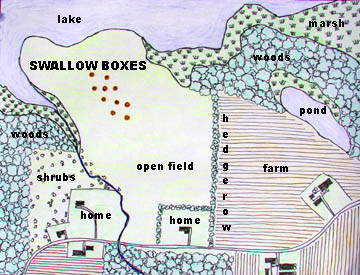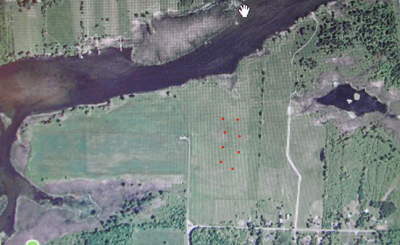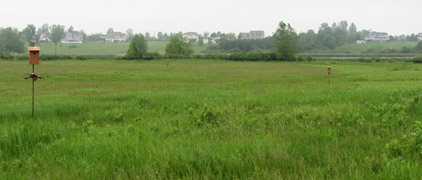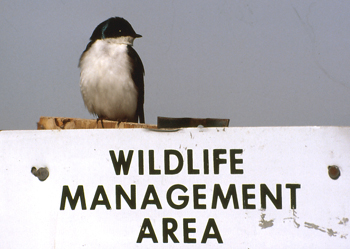Finding a good site for your Tree Swallow nest box project is extremely important.
Due to chronic shortages of cavities some Tree Swallows will try to nest in boxes put in dangerous places, where they face predation or nest competition. You don’t want to attract them to sites like that! These birds need nest boxes located where they can reproduce unharmed, and in or near habitat that supplies enough food for them and their young. Therefore, finding the right sites for Tree Swallow nest box projects is essential. You’ve learned their basic requirements. Now you can start searching for a project site that meets their needs.
Here’s what to look for when searching for sites for Tree Swallow boxes:
- Large open fields in rural areas near buggy wetlands often make great sites.
- Look for fields with few or no trees and shrubs. This makes flight easy for the swallows and viewing easy for you, plus it reduces competition from certain other species.
- Large open fields let you group widely spaced boxes out in the middle, away from houses, barns, woods, hedgerows, and water edges. This helps minimize competition from other cavity-nesting birds and cuts the chances predators can discover them.
- The drawing below shows an example of these good qualities.

Why open fields make good sites for Tree Swallow boxes
- Now it might seem that putting swallow boxes way out in the open makes them vulnerable, but the opposite is true.
- Most songbirds hide in dense vegetation when danger approaches, but not Tree Swallows. They rely on their flying ability to get away.
- Nest boxes that are well out in the open let the swallows spot incoming danger at a distance.
- Plus, raccoons, one of the most dangerous mammalian predators of Tree Swallow nests, hunt along edges of waterways, shores, woods, and hedgerows. And Tree Swallows’ worst bird competitors for cavities, House Sparrows, prefer boxes located near human dwellings or in shrubby areas. Placing boxes way out in fields greatly reduces risks from both these dangers.
- So, to repeat, look for large open fields far from buildings when scouting for potential project sites.
- Avoid fields used by livestock that could knock poles over.
- Also avoid fields that may be treated with agricultural pesticides or herbicides.
- Our own Salmon Creek Tree Swallow Project grid is in the middle of the open field below. The red dots represent swallow boxes. This site is among the wetlands of the Braddock Bay Wildlife Management Area of upstate NY.

- The three boxes visible below in our project are approximately 100 feet or 30 meters apart. We recommended this spacing for Tree Swallow boxes in order to reduce levels of competition for nest sites. Generally, we believe the farther apart, the better, if you have the room.

Get permission to erect your Tree Swallow nest box project
- You may be lucky and have a great location on your own property. However, if this isn’t the case you’ll probably need to get permission to erect boxes on someone else’s property.
- Often, the best potential locations are on public lands overseen by government natural resource personnel, or on land managed by private conservation or sporting groups. These folks may be happy to let you put nest boxes up.
- Private landowners, too, may agree to let you use their land, and may even assist you if invited.
- But remember, you always need to ask permission. So, prepare to explain what you intend to do and why.

Click here for your Next Step:
Nest Boxes for Tree Swallows
——————————————————————————-
Home: Tree Swallow Nest Box Projects
Creating Tree Swallow Nest Box Projects
Spring Return
Nesting Season Behavior
Song and Calls
Nest Site Claiming
Pair Formation
Nest Building
Bird Flight
Mating and Paternity
Diary of One Season at Salmon Creek
Monitoring Nest Boxes and Keeping Records
Making Box Checks Keeping Box Records Control Sheets Season Summaries Print Sheets
Banding Your Tree Swallows Banding Adults Banding Nestlings
Tree Swallows in Research Research Bibliography Glossary of Terms